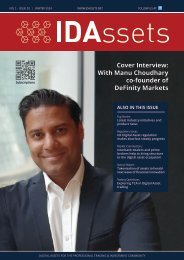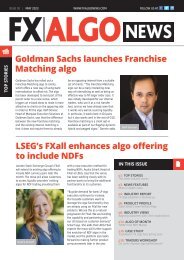e-Forex July 22
Create successful ePaper yourself
Turn your PDF publications into a flip-book with our unique Google optimized e-Paper software.
TRADING OPERATIONS<br />
Bringing more transparency and efficiency to the FX Liquidity Management process<br />
“Over the last five to ten years we’ve seen an increase in the<br />
level of detail in liquidity management reports. It is so much<br />
more complex because of the amount of data.”<br />
Geoff Jones<br />
because of the volume of data. People<br />
are not only using more liquidity<br />
providers but the market data also<br />
changes faster.”<br />
The profile of liquidity providers has<br />
also moved beyond those early days<br />
when there was a difference between<br />
bank and non-bank liquidity. “It is no<br />
longer a fair statement to say banks<br />
are good or execute one way or nonbanks<br />
are not and execute in others.<br />
Many non-banks are genuine liquidity<br />
providers,” says Jones.<br />
“There was a period when a number<br />
of third parties were building<br />
platforms that enabled takers to<br />
bypass measures designed to protect<br />
liquidity providers and maintain good<br />
liquidity. So whilst the focus of the<br />
industry has been on liquidity provider<br />
behaviour, there is a responsibility<br />
on platforms and clients to ensure<br />
good market practice. Some of this<br />
technology was imported from other<br />
asset classes with centralised rather<br />
than over-the-counter trading. In OTC<br />
markets is not just about technology<br />
but also about relationships,” says<br />
Jones. “As a liquidity manager, we<br />
have the ability to see everything<br />
which means we can facilitate<br />
effective conversations between<br />
liquidity providers and takers.<br />
Good liquidity providers set out<br />
their expectations and good clients<br />
understand what is expected of them.<br />
Not all firms have access to the data to<br />
support these conversations but there<br />
are a lot of independent firms out<br />
there that can support smaller firms.<br />
Clients and liquidity providers are<br />
doing themselves a disservice by not<br />
using this data.”<br />
“Markout data plays the biggest role,<br />
it gives you an idea of how both sides<br />
behave. Transaction cost analysis (TCA)<br />
and peer analysis is also powerful.<br />
The data and analytics help support<br />
conversations that should be taking<br />
place” says Jones.<br />
“Liquidity management can be done<br />
without independent providers but<br />
the question is ‘what do I not know?’.<br />
That peer analysis cannot be done on<br />
a bilateral basis. That level of analysis<br />
really lends itself to providers like<br />
Refintiv supporting the FX liquidity<br />
management process. It can help the<br />
Liquidity Provider realise when they are<br />
an anomaly,” he says.<br />
GREAT RESPONSIBILITY<br />
When it comes to the evolution<br />
of liquidity management, one of<br />
the biggest changes has been a<br />
much greater awareness by market<br />
participants of their responsibilities<br />
when they engage with their liquidity<br />
providers.<br />
“Liquidity managers at tier 2 banks<br />
are cognisant that they are part of a<br />
wider ecosystem and that to get the<br />
best pricing from the best liquidity<br />
providers, you have to take more<br />
responsibility for your flow,” says John<br />
Stead, Global Head of Pre-Sales at<br />
smartTrade. “If you are just smashing<br />
the market, you will get wide spreads<br />
or just cut off.”<br />
An important development on the technology side has been the use of artifi cial intelligence and machine learning<br />
to produce predictive analytics<br />
There are a number of drivers that<br />
have accelerated the evolution of<br />
liquidity management, says Stead.<br />
“Firstly, there is less ‘fat’ in the<br />
industry as a whole. Tier 1 banks<br />
are facing ever tighter margins and<br />
are looking more closely at liquidity<br />
and the trading patterns of their<br />
counterparties. Secondly, there is also<br />
more technology available to liquidity<br />
providers to identify bad behaviour<br />
from underlying price takers. For<br />
example, technology such as<br />
smartTrade’s AI Analytics allows banks<br />
to analyse clients’ trading patterns<br />
<strong>22</strong> JULY 20<strong>22</strong> e-FOREX

















